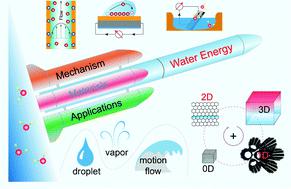当前位置:
X-MOL 学术
›
Chem. Soc. Rev.
›
论文详情
Our official English website, www.x-mol.net, welcomes your
feedback! (Note: you will need to create a separate account there.)
Hydrovoltaic technology: from mechanism to applications
Chemical Society Reviews ( IF 40.4 ) Pub Date : 2022-05-31 , DOI: 10.1039/d1cs00778e Xiaofan Wang 1 , Fanrong Lin 1 , Xiang Wang 1 , Sunmiao Fang 1 , Jin Tan 1 , Weicun Chu 1 , Rong Rong 1 , Jun Yin 1 , Zhuhua Zhang 1 , Yanpeng Liu 1 , Wanlin Guo 1
Chemical Society Reviews ( IF 40.4 ) Pub Date : 2022-05-31 , DOI: 10.1039/d1cs00778e Xiaofan Wang 1 , Fanrong Lin 1 , Xiang Wang 1 , Sunmiao Fang 1 , Jin Tan 1 , Weicun Chu 1 , Rong Rong 1 , Jun Yin 1 , Zhuhua Zhang 1 , Yanpeng Liu 1 , Wanlin Guo 1
Affiliation

|
Water is a colossal reservoir of clean energy as it adsorbs thirty-five percent of solar energy reaching the Earth's surface. More than half of the adsorbed energy turns into latent heat for water evaporation, driving the water cycle of the Earth.1 Yet, only very limited energy in the water cycle is harvested by current industrial technologies. The past decade has witnessed the emergence of hydrovoltaic technology, which generates electricity from nanomaterials by direct interaction with water and enables energy harvesting from the water cycle such as from rain, waves, flows, moisture and natural evaporation. Years of efforts have been committed to improve the conversion efficiency of hydrovoltaic devices through chemical synthesis of advanced nanomaterials and innovative design of device structures. Further development of this field, however, still requires in-depth understanding of hydrovoltaic mechanisms and boosting of the electrical outputs for wider applications. Here, we present a tutorial review of different mechanisms of generating electricity from droplets, flows, natural evaporation and ambient moisture by analyzing basic interactions at various water–material interfaces. Key aspects in raising the output power of hydrovoltaic devices are then discussed in terms of material synthesis, structural design, and device optimization. We also provide an outlook on the potential applications of this technology ranging from sensors, power suppliers to multifunctional systems as well as on the scientific and technological challenges in transforming its potential into practical utility. The prospects of this emerging field are considered for future endeavor.
中文翻译:

水电技术:从机理到应用
水是一个巨大的清洁能源库,因为它吸收了 35% 到达地球表面的太阳能。超过一半的吸附能量转化为水蒸发的潜热,推动地球的水循环。1然而,目前的工业技术只能在水循环中获取非常有限的能量。过去十年见证了水力发电技术的出现,该技术通过与水的直接相互作用从纳米材料中发电,并能够从水循环中收集能量,例如雨水、波浪、水流、水分和自然蒸发。多年来一直致力于通过先进纳米材料的化学合成和器件结构的创新设计来提高水电器件的转换效率。然而,该领域的进一步发展仍需要深入了解水力发电机制并提高电力输出以实现更广泛的应用。在这里,我们介绍了从液滴、流动、通过分析各种水-材料界面的基本相互作用,自然蒸发和环境湿度。然后从材料合成、结构设计和设备优化方面讨论了提高水电设备输出功率的关键方面。我们还展望了这项技术的潜在应用,从传感器、电源供应器到多功能系统,以及将其潜力转化为实用性的科学和技术挑战。这个新兴领域的前景被认为是未来的努力。我们还展望了这项技术的潜在应用,从传感器、电源供应器到多功能系统,以及将其潜力转化为实用性的科学和技术挑战。这个新兴领域的前景被认为是未来的努力。我们还展望了这项技术的潜在应用,从传感器、电源供应器到多功能系统,以及将其潜力转化为实用性的科学和技术挑战。这个新兴领域的前景被认为是未来的努力。
更新日期:2022-05-31
中文翻译:

水电技术:从机理到应用
水是一个巨大的清洁能源库,因为它吸收了 35% 到达地球表面的太阳能。超过一半的吸附能量转化为水蒸发的潜热,推动地球的水循环。1然而,目前的工业技术只能在水循环中获取非常有限的能量。过去十年见证了水力发电技术的出现,该技术通过与水的直接相互作用从纳米材料中发电,并能够从水循环中收集能量,例如雨水、波浪、水流、水分和自然蒸发。多年来一直致力于通过先进纳米材料的化学合成和器件结构的创新设计来提高水电器件的转换效率。然而,该领域的进一步发展仍需要深入了解水力发电机制并提高电力输出以实现更广泛的应用。在这里,我们介绍了从液滴、流动、通过分析各种水-材料界面的基本相互作用,自然蒸发和环境湿度。然后从材料合成、结构设计和设备优化方面讨论了提高水电设备输出功率的关键方面。我们还展望了这项技术的潜在应用,从传感器、电源供应器到多功能系统,以及将其潜力转化为实用性的科学和技术挑战。这个新兴领域的前景被认为是未来的努力。我们还展望了这项技术的潜在应用,从传感器、电源供应器到多功能系统,以及将其潜力转化为实用性的科学和技术挑战。这个新兴领域的前景被认为是未来的努力。我们还展望了这项技术的潜在应用,从传感器、电源供应器到多功能系统,以及将其潜力转化为实用性的科学和技术挑战。这个新兴领域的前景被认为是未来的努力。











































 京公网安备 11010802027423号
京公网安备 11010802027423号